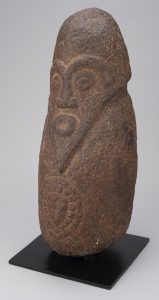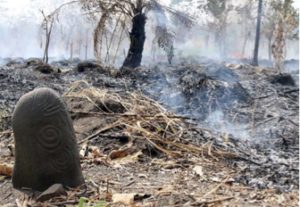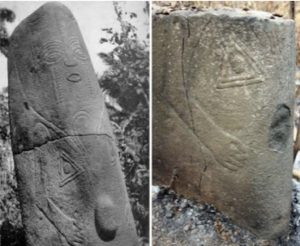
Ejagham artist, Nigeria, Akwanshi, c. 16th Century, Stone, Museum purchase with Françoise Billion Richardson and Gordy funds, 2019.11
Ancestors in Stone showcases a recently acquired sixteenth-century akwanshi stone monolith from the Cross River region of Nigeria, along with figures and objects collectively made with stones. The exhibition, on view through the summer of 2020, speaks to the significance of stone both as a natural element and as a significant material in the veneration of West African forebears. These stones have been venerated by many cultures of the Cross River region of south eastern Nigeria.
Akwanshi stone sculptures were first documented by British anthropologist Charles Partridge at the turn of the twentieth century. In his book Cross River Natives (1905), he identified their presence within the Ikom area. However, it was Allison Philip, a British-colonial forestry specialist, who conducted the first organized research on the monoliths in the late 1960s. Based upon conclusions derived from archaeology in the area, Eyo Ekpo, director of Nigeria’s Department of Antiquities and head of Nigeria’s National Museums, suggests a plausible date that compares with the Nok culture (c. 300 BC). But it is a combination of the aesthetic appeal and the source and meaning encoded in the monoliths, which are yet to be fully deduced, that continues to intrigue and excite many scholars and collectors.
Akwanshi (stone of dead ancestors) are carved to depict a human face (mostly male). Facial features are characterized by round or lentoid eyes, and an oval mouth. The nose on some stones is depicted as simple modeled vertical lines, while in others it forms a molded raised triangle. Eyebrows sometime appear, but it is difficult to be certain that there is any deliberate attempt to represent ears. Besides the upper part of the monoliths that suggest facial features, the abdominal area is almost untouched but for some inscriptions in the form of scarification and other types of decorative markings. Some scholars have suggested that these markings align with an ancient secret writing system within the area popularly referred to by the Ejagham people as “nsibidi.” Others have associated some of the markings on the stones to other forms of writing. The inscriptions are considered a form of ancient technology, requiring specialized tools that allowed the carvers to make the markings.
Some stones have entered the art market while others have been desecrated in situ. Currently, the stones suffer due to poor site management. The absence of serious conservation practices is compounded by a lack of government funding to care for these antiquties. Vandalism by way of bush burning, deliberate destruction and defacing, and mindless theft of the Akwanshi from their original sites are but some of the problems that the remaining stones face. The ancestral stones are at eventual risk of nearly total loss due to these conditions.
In many African cultures, visual representation of ancestors was done with ephemeral and perishable materials. This was predicated on the thinking that impermanence of material helps to capture the essence of the spirit. They are supposed to return only when their services are needed in the community. Indeed, after consecration and use, the indwelled spirit goes away and the object is left to disintegrate. For example, mbari mud sculpture dwellings, created by the Igbo people for the propitiation of Ala, a female earth deity, are intentionally abandoned upon completion. It is considered taboo to maintain or step inside these sacred structures and they are purposely left to decay in the elements. What happens when ancestral figures are rendered in a more permanent material such as stones? Will they still be left to disintegrate after they have exhausted their relevance? Is the use of stones and other permanent materials another way of making the presence of the spirit more permanent?
Ancestors in Stone includes objects in stone, terracotta and other materials. The display will include a miniature nomoli stone figurine—loaned from Charlie and Kent Davis—and another stone ancestral figure from the Mambila people of Nigeria/Cameroon.
—Ndubuisi Ezeluomba, François Billion Richardson Curator of African Art

